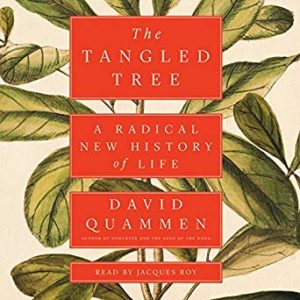Trunks, branches and twigs, oh my!!
Author: David Quammen
 It’s been the metaphor that all the other metaphors wish they could be. When describing life on earth, the tree has been the visual of choice, ever since Darwin. Humbly and simply symbolizing life’s connections with countless trunks, branches and twigs, it’s truly awe-inspiring in its scope. But nothing is ever as simple as it seems and in The Tangled Tree, acclaimed science journalist David Quammen reveals the many ways that this most hallowed of biological metaphors has fallen victim to modern science. It’s really an incredible read.
It’s been the metaphor that all the other metaphors wish they could be. When describing life on earth, the tree has been the visual of choice, ever since Darwin. Humbly and simply symbolizing life’s connections with countless trunks, branches and twigs, it’s truly awe-inspiring in its scope. But nothing is ever as simple as it seems and in The Tangled Tree, acclaimed science journalist David Quammen reveals the many ways that this most hallowed of biological metaphors has fallen victim to modern science. It’s really an incredible read.
Quammen uses the tree as the framework for the entire book, revealing how scientific understanding of the tree of life has evolved, from its pre-Darwinian origins to its subsequent modifications and permutations over the many decades. He returns to the concept repeatedly as the story gradually picks up speed.
In a stroke of biological irony, the author explores how the smallest of biological units played a key role in transforming and eventually tangling Darwin’s mighty tree. Behold the lowly ribosome, the tiny factory in every cell that reads simple messenger RNA molecules and converts them into complex proteins. Over and over again. There may be as many as 10 million of them in every kind of cell on the planet. But despite their ubiquity, there’s no question that they’re as essential as they are diminutive and mundane.
It was the universality of the ribosome that attracted scientist Carl Woese to them in the first place. He reasoned that such an essential part of life’s cellular machinery must have been present back to the very beginnings of life billions of years ago. In great detail, Quammen explains how Woese used the ribosome to rewrite the ancient history of life in a way that few of his colleagues were willing to accept. The resulting controversies, disputes and conflicts make for some dramatic and consistently fascinating reading.
While the science is interesting, the author wisely orients his account around the lives of actual scientists like Woese, also including Lynn Margulis, whose once heretical views on the bacterial origins of mitochondria and chloroplasts caused similar upheavals at the base of Darwin’s evolutionary tree. Somehow, even though his narrative revolves around researchers in white lab coats processing data and scribbling on chalkboards, Quammen puts a human face on the endeavor and makes the entire adventure consistently intriguing and entertaining. It’s a remarkable achievement in scientific storytelling.
While the first part of the book looks at the initial discoveries that threatened Darwin’s tree metaphor, Quammen uses the last part of the book to fully tackle the “tangled” part of the story. It’s called horizontal gene transfer and the more scientists have searched for this phenomenon, the more they’ve realized that the Darwinian concept of a vertically oriented ancestral tree – with a twig for every species extant or extinct – doesn’t adequately explain life on earth. Bacteria and viruses are especially good at sharing their DNA with other species, but it turns out that animals can do it as well. As a result of all this sharing, it turns out that our genetic makeup – and that of most other plants and animals – contains a significant percentage of viral and bacterial DNA. It’s really a pretty revolutionary concept. Those who choose to believe in the evolutionary explanation of life on earth might be content with the idea that we share a lot of DNA with our chimpanzee brethren, with decreasing amounts shared with more distantly related creatures like luna moths or apple trees. But the idea that, bacterial and viral DNA also make up a substantial – and functionally important – contribution goes against the previously accepted evolutionary concept that the tree of life had so capably represented for so long.
Given the density, complexity and convoluted nature of the topic, the author’s writing is remarkably easy to read. He repeatedly uncovers the essential details, explains them well and then uses those details to construct a wide-ranging story. His style is consistently conversational, free flowing and he frequently harkens back to previous topics for emphasis. I call it literary affability and Quammen displays it as well as any science writer I know.
I also appreciate his thoughtful treatment of Charles Darwin’s legacy. Rather than focusing on the “Darwin was wrong” angle – so frequently emphasized in the lay press – he chooses the much more rational and accurate route, acknowledging the man’s genius and priceless contributions while exploring the many ways that the traditional Darwinian tree of life no longer best represents reality. He doesn’t destroy Darwin – who made all of his discoveries without any knowledge of genetics or cellular biology – but rather looks at Darwin’s contributions as the essential initial steps that they were.
Revealing a thoroughly modern – and often quite perplexing – look at life on earth, The Tangled Tree is a remarkably entertaining book that questions the very idea of individuality. It presents a consistently intriguing look at science as it’s actually done, by humans with biases, irrationalities and daily struggles. Fans of Quammen’s previous works are sure to pleased and it makes an excellent companion volume to two other science books I’ve reviewed recently: She Has Her Mother’s Laugh by Carl Zimmer and I Contain Multitudes by Ed Yong. Each book looks at modern biological science from a different but entirely compatible perspective, supporting the others nicely. I recommend Quammen’s book as enthusiastically as I did the other two.
— D. Driftless
Woese photo by Don Hamerman (CC BY 3.0) / Margulis photo by Jpedreira (CC BY-SA 2.5)
Check out Dave’s reviews of other Quammen books: Spillover / Ebola
Dave’s reviewed a lot of books about evolution. Feel free to check out some of these as well: The Universe Within / The Monkey’s Voyage / The Violinist’s Thumb
[AMAZONPRODUCTS asin=”1476776636″]
- Best Non-Fiction of 2016 - February 1, 2017
- Little Free Library Series — Savannah - May 22, 2015
- Little Free Library Series — Wyoming - November 30, 2014



